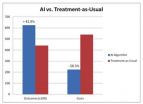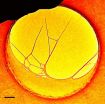(Press-News.org) New research from Indiana University has found that machine learning - the same computer science discipline that helped create voice recognition systems, self-driving cars, and credit card fraud detection systems - can drastically improve both the cost and quality of health care in the United States.
Using an artificial intelligence framework combining Markov Decision Processes and Dynamic Decision Networks, IU School of Informatics and Computing researchers Casey Bennett and Kris Hauser show how simulation modeling that understands and predicts the outcomes of treatment could reduce health care costs by over 50 percent while also improving patient outcomes by nearly 50 percent.
The work by Hauser, an assistant professor of computer science, and Ph.D. student Bennett improves upon their earlier work that showed how machine learning could determine the best treatment at a single point in time for an individual patient.
By using a new framework that employs sequential decision-making, the previous single-decision research can be expanded into models that simulate numerous alternative treatment paths out into the future, maintain beliefs about patient health status over time even when measurements are unavailable or uncertain, and continually plan/re-plan as new information becomes available. In other words, it can "think like a doctor."
"The Markov Decision Processes and Dynamic Decision Networks enable the system to deliberate about the future, considering all the different possible sequences of actions and effects in advance, even in cases where we are unsure of the effects," Bennett said.
Moreover, the approach is non-disease-specific - it could work for any diagnosis or disorder, simply by plugging in the relevant information.
The new work addresses three vexing issues related to health care in the U.S.: rising costs expected to reach 30 percent of the gross domestic product by 2050; a quality of care where patients receive correct diagnosis and treatment less than half the time on a first visit; and a lag time of between 13 and 17 years between research and practice in clinical care.
"We're using modern computational approaches to learn from clinical data and develop complex plans through the simulation of numerous, alternative sequential decision paths," Bennett said. "The framework here easily out performs the current treatment-as-usual, case-rate/fee-for-service models of healthcare."
Bennett is also a data architect and research fellow with Centerstone Research Institute, the research arm of Centerstone, the nation's largest not-for-profit provider of community-based behavioral health care. The two researchers had access to clinical data, demographics, and other information on over 6,700 patients who had major clinical depression diagnoses, of which about 65-70 percent had co-occurring chronic physical disorders like diabetes, hypertension, and cardiovascular disease.
Using 500 randomly selected patients from that group for simulations, the two compared actual doctor performance and patient outcomes against sequential decision-making models, all using real patient data. They found great disparity in the cost per unit of outcome change when the artificial intelligence model's cost of $189 was compared to the treatment-as-usual cost of $497.
"This was at the same time that the AI approach obtained a 30 to 35 percent increase in patient outcomes," Bennett said. "And we determined that tweaking certain model parameters could enhance the outcome advantage to about 50 percent more improvement at about half the cost."
While most medical decisions are based on case-by-case, experience-based approaches, there is a growing body of evidence that complex treatment decisions might best be handled through modeling rather than intuition alone.
"Modeling lets us see more possibilities out to a further point, which is something that is hard for a doctor to do," Hauser said. "They just don't have all of that information available to them."
Using the growing availability of electronic health records, health information exchanges, large public biomedical databases, and machine learning algorithms, the researchers believe the approach could serve as the basis for personalized treatment through integration of diverse, large-scale data passed along to clinicians at the time of decision-making for each patient. Centerstone alone, Bennett noted, has access to health information on over one million patients each year.
"Even with the development of new AI techniques that can approximate or even surpass human decision-making performance, we believe that the most effective long term path could be combining artificial intelligence with human clinicians," Bennett said. "Let humans do what they do well, and let machines do what they do well. In the end, we may maximize the potential of both."
INFORMATION:
"Artificial Intelligence Framework for Simulating Clinical Decision-Making: A Markov Decision Process Approach," was published recently in Artificial Intelligence in Medicine. The research was funded by the Ayers Foundation, the Joe C. Davis Foundation and Indiana University.
Can computers save health care? IU research shows lower costs, better outcomes
Cost per unit of outcome was $189, versus $497 for treatment-as-usual
2013-02-11
ELSE PRESS RELEASES FROM THIS DATE:
Obesity, excess weight gain during pregnancy linked to heavier babies in African-American women
2013-02-11
(Boston) – Epidemiologists at Boston University School of Public Health (BUSPH) have found that pre-pregnancy obesity and excess weight gain during pregnancy in African-American women are associated with an increased risk of giving birth to an abnormally large baby. Macrosomia, which is defined as a newborn weighing more than 4,000 grams at birth (approximately 8.8 pounds), can cause delivery complications such as hemorrhage, infection, the need for a caesarean section, preeclampsia and perinatal mortality. The study, which appears online in the journal Obesity, was conducted ...
Anxiety about relationships may lower immunity, increase vulnerability to illness
2013-02-11
COLUMBUS, Ohio – Concerns and anxieties about one's close relationships appear to function as a chronic stressor that can compromise immunity, according to new research.
In the study, researchers asked married couples to complete questionnaires about their relationships and collected saliva and blood samples to test participants' levels of a key stress-related hormone and numbers of certain immune cells.
The research focused on attachment anxiety. Those who are on the high end of the attachment anxiety spectrum are excessively concerned about being rejected, have a ...
Noisy classroom simulation aids comprehension in hearing-impaired children
2013-02-11
Children with hearing loss struggle to hear in noisy school classrooms, even with the help of hearing aids and other devices to amplify their teacher's voice. Training the brain to filter out background noise and thus understand spoken words could help the academic performance and quality of life for children who struggle to hear, but there's been little evidence that such noise training works in youngsters.
A new report showed about a 50 percent increase in speech comprehension in background noise when children with hearing impairments followed a three-week auditory ...
Large, ancient landslides delivered preferred upstream habitats for coho salmon
2013-02-11
EUGENE, Ore. (Feb. 11, 2013) -- A study of the Umpqua River basin in the Oregon Coast Range helps explain natural processes behind the width of valleys and provides potentially useful details for river restoration efforts designed to improve habitats for coho salmon (Oncorhynchus kisutch).
Coho salmon thrive in broad, flat valleys that contain multiple auxiliary channels to the main river. These valleys formed after large landslides altered the landscape, said study co-author Joshua J. Roering, professor of geological sciences at the University of Oregon. The network ...
Visualizing biological networks in 4-D
2013-02-11
PASADENA, Calif.—Every great structure, from the Empire State Building to the Golden Gate Bridge, depends on specific mechanical properties to remain strong and reliable. Rigidity—a material's stiffness—is of particular importance for maintaining the robust functionality of everything from colossal edifices to the tiniest of nanoscale structures. In biological nanostructures, like DNA networks, it has been difficult to measure this stiffness, which is essential to their properties and functions. But scientists at the California Institute of Technology (Caltech) have recently ...
Old drug may point the way to new treatments for diabetes and obesity
2013-02-11
ANN ARBOR — Researchers at the University of Michigan's Life Sciences Institute have found that amlexanox, an off-patent drug currently prescribed for the treatment of asthma and other uses, also reverses obesity, diabetes and fatty liver in mice.
The findings from the lab of Alan Saltiel, the Mary Sue Coleman director of the Life Sciences Institute, are scheduled to be published online Feb. 10 in the journal Nature Medicine.
"One of the reasons that diets are so ineffective in producing weight loss for some people is that their bodies adjust to the reduced calories ...
New genes for short-sightedness identified
2013-02-11
An international team of scientists led by King's College London has discovered 24 new genes that cause refractive errors and myopia (short-sightedness).
Myopia is a major cause of blindness and visual impairment worldwide, and currently there is no cure. These findings, published today in the journal Nature Genetics, reveal genetic causes of the trait, which could lead to finding better treatments or ways of preventing the condition in the future.
Thirty per cent of Western populations and up to 80 per cent of Asian people suffer from myopia. During visual development ...
NIH scientists discover promising target to block Staphylococcus infection
2013-02-11
National Institutes of Health (NIH) scientists have identified a promising lead for developing a new type of drug to treat infection caused by Staphylococcus aureus, a bacterium that frequently resists traditional antibiotics. The researchers discovered a system used by S. aureus to transport toxins that are thought to contribute to severe staph infections. These toxins—called phenol-soluble modulins (PSMs)—have gained much attention in recent years, but their multitude and diversity have hindered efforts to target them for drug development.
Expanding on work that first ...
Birds evolved ultraviolet vision several times
2013-02-11
Ultraviolet vision evolved at least eight times in birds from a common violet sensitive ancestor finds a study published in BioMed Central's open access journal BMC Evolutionary Biology. All of these are due to single nucleotide changes in the DNA.
Modern daytime birds either have violet sensitive or ultraviolet sensitive vision. Being ultraviolet sensitive alters visual cues used to select a mate, avoiding predators, and in finding food. Researchers from Uppsala University and the Swedish University of Agricultural Sciences sequenced the genes responsible for producing ...
U of M researchers develop a molecular 'calcium sponge' to tackle heart failure
2013-02-11
MINNEAPOLIS/ST. PAUL (February 10, 2013) – Researchers at the University of Minnesota's Department of Integrative Biology and Physiology and the Lillehei Heart Institute have utilized molecular genetic engineering to optimize heart performance in models of diastolic heart failure by creating an optimized protein that can aid in high-speed relaxation similar to fast twitching muscles.
Within heart cells, calcium plays a major role in orchestrating normal heart pump function. However, in diastolic failure the calcium signaling process is slowed; calcium levels rise to ...
LAST 30 PRESS RELEASES:
Polyphenol-rich diets linked to better long-term heart health
Tai chi as good as talking therapy for managing chronic insomnia
Monthly injection helps severe asthma patients safely stop or reduce daily steroids
The Lancet Respiratory Medicine: Monthly injection may help severe asthma patients safely reduce or stop daily oral steroid use
Largest study reveals best treatment options for ADHD
Tsunami from massive Kamchatka earthquake captured by satellite
Hidden dangers in 'acid rain' soils
Drug developed for inherited bleeding disorder shows promising trial results
New scan could help millions with hard-to-treat high blood pressure
9th IOF Asia-Pacific Bone Health Conference set to open in Tokyo
Can your driving patterns predict cognitive decline?
New electrochemical strategy boosts uranium recovery from complex wastewater
Study links America’s favorite cooking oil to obesity
Famous Easter Island statues were created without centralized management
Captive male Asian elephants can live together peacefully and with little stress, if introduced slowly and carefully, per Laos case study of 8 unrelated males
The Galapagos and other oceanic islands and Marine Protected Areas (MPAs) may be "critical" refuges for sharks in the Tropical Eastern Pacific, as predatory fish appear depleted in more coastal MPAs t
Why are shiny colours rare yet widespread in nature?
Climate-vulnerable districts of India face significantly higher risks of adverse health outcomes, including 25% higher rates of underweight children
New study reveals spatial patterns of crime rates and media coverage across Chicago
Expanding seasonal immunization access could minimize off-season RSV epidemics
First-of-its-kind 3D model lets you explore Easter Island statues up close
foldable and rollable interlaced origami structure: Folds and rolls up for storage and deploys with high strength
Possible therapeutic approach to treat diabetic nerve damage discovered
UBC ‘body-swap’ robot helps reveal how the brain keeps us upright
Extensive survey of Eastern tropical Pacific finds remote protected areas harbor some of the highest concentrations of sharks
High risk of metastatic recurrence among young cancer patients
Global Virus Network statement on the Marburg virus outbreak in Ethiopia
'Exploitative' online money gaming in India causing financial, health and social harm, analysis shows
Mayo Clinic researchers identify why some lung tumors respond well to immunotherapy
The pterosaur rapidly evolved flight abilities, in contrast to modern bird ancestors, new study suggests
[Press-News.org] Can computers save health care? IU research shows lower costs, better outcomesCost per unit of outcome was $189, versus $497 for treatment-as-usual


